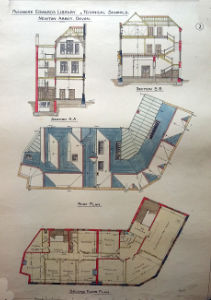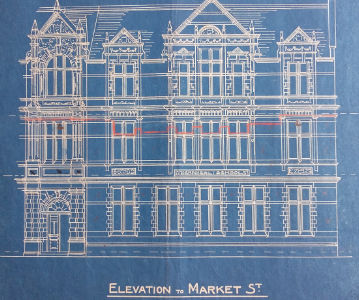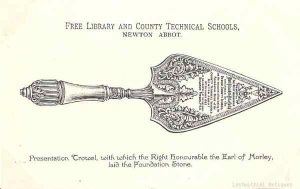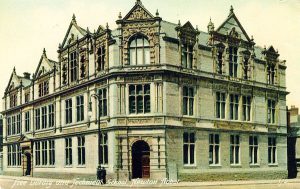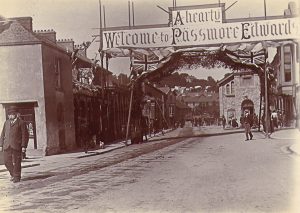Erected to the memory of Passmore Edwards’ mother this was, perhaps, the finest of the buildings that he was associated with.
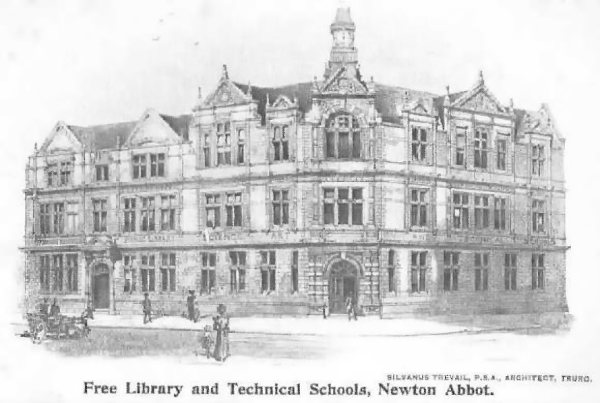
History
When Passmore Edwards met H T Parker, a member of the Newton Abbot Council at a masonic meeting in London he expressed a wish to provide a hospital for Newton Abbot in memory of his mother who had been born there, in a house in Wolborough Street. Newton Abbot already had its hospital but Passmore Edwards was easily persuaded to provide a Free Library instead. Then arose the proposal to build a Technical School in conjunction with the library and for this to be a celebration of the Coronation of King Edward VII.
Sylvanus Trevail was instructed to draw up the plans but when he presented these to the Council their elaborate and costly nature took them by surprise and pessimistic views were expressed about the feasibility of the project. However, the plans were presented to the Devon County Council and an application lodged for a grant towards the costs. The County Council agreed to provide half of the costs of the School, up to a maximum of £2700, the Town Council’s contribution to include the site.
The site chosen had been originally purchased for road improvements but with the help of the Right Hon C Seale-Hayne MP the Local Government Board were persuaded to release the land for this new use.
Tenders were let and contracts awarded to Mr H Goss of Torquay for the construction of the Library (£2,290) and Schools (£3,543).
Public subscriptions were canvassed towards the building fund and within a few weeks £1,200 was promised, including £200 from Mr Seale-Hayne. Passmore Edwards contribution for the Free Library was £2,500.
Work progressed very slowly and it eventually became apparent that Mr Goss would be unable to complete the contracts and negotiations were entered into with Mr F A A Stacey, who had been amongst the original tenderers, and who agreed to take over the contracts at no extra cost.
Library and Schools stand on a corner site and the road improvements display them to a great advantage.The front elevation is of worked limestone with buff terra cotta dressings. The gables, quoins, window and doorway frameworks, and facias are all terra cotta as are the names of the buildings, set out across the full front elevation.
The clock turret, included in the origianl drawings, was omitted and over the central windows of the school there is a pediment with the carved arms of Newton Abbot and Newton Bushell.
At Passmore Edwards request, the library, although forming a part of the whole group, is practically a separate building from foundations to roof. It occupies part of the frontage to the extreme left. Over the entrance is insrcibed “This building was presented to the town by J Passmore Edwards Esq, in memory of his mother.
On the right of the entrance was the general reading room for papers and periodicals, whilst to the left was the magazine room and directly opposite was the ladies room. From the entrance hall the wideeasy staircase gave access to the first floor. Here was situated the main lending library with the librarian’s office leading off through an archway. The borrowers lobby was situated on the stairway landing. There was also a reference library and committee room on this floor. On the second floor were the caretaker’s rooms, with 3 bedrooms,and a large book store. A doorway on this floor gave access to the Schools but in all other aspects the two buildings were seperate.
The technical schools had an access on both Market and Bank Streets. A fine entrance lobby and entrance hall gave access to the rooms on the ground floor. Opening from the central hall was a large room for machine drawing and building construction. Adjoining this was the principal’s and secretary’s offices. Another large room was set aside for science and technical classes. There was also a photographic dark room. All of the floors were wood block over a cement base. A broad staircase lead to the first floor where on the wide landing wooden disdlay cases were filled with fossils and corals given to the schools by Wm J Vicary JP. The first floor is given over to science laboratories, and lecture and demonstration rooms whilst on the second floor accommodation was made for the artists with rooms for painting, drawing, pottery and casting and wood carving. The whole building was heated by water filled radiators and ducted hot air from boilers installed in the cellars beneath the school buildings.
After Trevail’s suicide, his assistant, A J Cornelius , of Truro, took over the architectural work.The Devon County Council insisted that the furnishings and equipment of the schools was to be of the most up to date and the library likewise accommodated the most up to date equipment. The library furnishings were funded from an accumulation of the library penny rate that had been levied from the time that the library was first proposed whilst the £1000 with which to furnish and equip the schools was provided by a grant of £750 from the County Council and the remainder raised, mainly,through the efforts of Wm Vicary.
The ultimate success of the library was due in no small measure to the first librarian, William Maddern, who came from Penzance. Passmore Edwards endowed each of his libraries with a number of books but it fell to Mr Maddern to add to these where ever and by whatever means as was possible. The GWR Mechanics Institute of Newton Abbot gave 1000 books, the entire content of its library, whilst the British Museum gave 163 volumes. Individual donations of both books and money were also received from many of the local families and businesses and by the end of the first year of operation an additional 2,215 volumes had been obtained with a total stock of over 5,000 volumes. The number of borrowers totalled 1,461 and total issues of 33,026 in the first year increased to 41,217 by the end of the second.
The penny rate raised £200 in the early 1900’s which financed the years activities, including the librarian’s salary and caretaking costs.
Current Use
In December 2009 Devon County Council approved plans for a major, £2.3 million, restoration and extension of the library, to produce the first of Devon’s new generation of public libraries, creating a hub for the community. In order to carry out the work the library closed in August 2010 but will reopen in 2011, the centenary year of the death of its benefactor.
